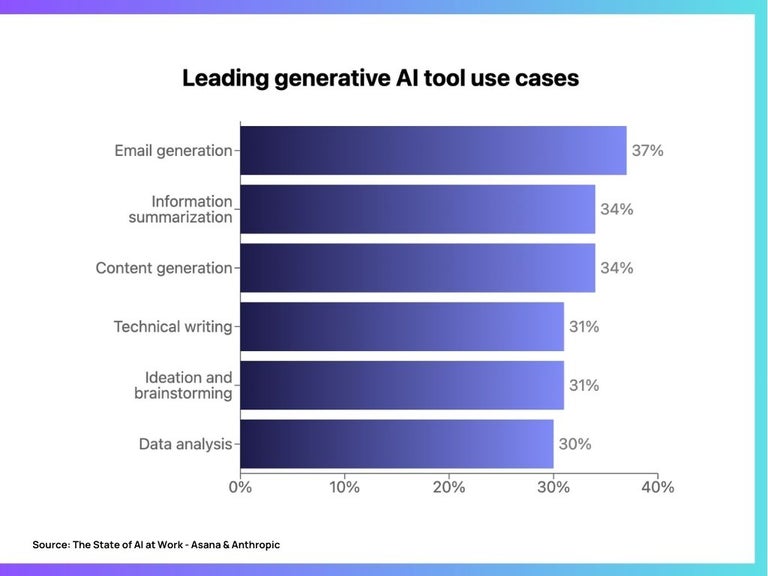Contents
- 1. Harness Your Brain's Night Shift With a To-Do List
- 2. AI, Your 24/7 Productivity Sidekick
- 3. Sharpen Your Decision-Making With the Decision Audit
- 4. Unleash Your Focus With the Offload Protocol
- 5. Boost Productivity With Strategic Breaks
- 6. Replace Time-Sucking Meetings With Videos
- Start Creating Your Personal Productivity System
Is your dream job abroad turning into a productivity nightmare? Don't pack up your home office just yet! Our 6 productivity hacks for remote workers are set to turn your remote productivity woes on their head.
The allure of working remotely from another country is undeniable. What used to be a thing of remote job daydreams has fast become commonplace.
But the reality of shifting to remote work can hit remote work newbies like a cold shower.
Managing endless video calls across time zones, a work-life balance that's more mythical than magical, and the constant gut-wrenching fear that your manager thinks you're sipping Mai Tais instead of meeting deadlines.
As much as the in-office doomsayers want you to believe it, remote work isn't to blame. You might be a couple well placed hacks away from productivity bliss!
We've done the hard work and compiled 6 power-packed productivity hacks that are about to flip your remote work game on its head.
These aren't just feel-good tips – they're battle-tested interventions that can transform your workday from stress fest to productivity party.
Ready to stop treading water and start living that remote work dream?
1. Harness Your Brain's Night Shift With a To-Do List
Picture this: It's 3 AM, and you're wide awake, mind looping faster than a superbike in the Globe of Death.
"Did I send that report to Sarah?"
"What was that brilliant idea I had about client onboarding during dinner?"
"I can't forget to chase that software vendor tomorrow."
Sound familiar?
We've all experienced this tossing and turning nightmare. Mentally rehearsing work conversations, puzzling over stubborn Excel formulas, and fretting about that urgent email sitting in your inbox.
All the while knowing this missed sleep will have you dragging yourself through tomorrow.
It’s all too easy to crack open your laptop and start trying to problem-solve. Next thing you know, it’s 7 AM, you’re three synchronous conversations deep with your colleague across the pond and the day’s in full swing.
All with batteries hurtling dangerously towards zero.
But what if you could turn your nights into your secret productivity weapon (no wakeful hours required)? Enter the humble bedtime to-do list.
Here's how to put this strategy into action:
- Before you hit the hay, grab a dedicated notebook.
- Jot down your top 3-5 priorities for tomorrow. Be specific – "Send Q3 report to Sarah," "Draw up a client onboarding map," "Call software vendor re: contract terms."
- If other thoughts are buzzing around, quickly note them in a separate section below your main list.
- Close your notebook, and let your subconscious take the wheel.
Why does this work?
While you're catching Z's, your brain's in diffuse mode, quietly connecting dots, generating ideas, and preparing you for the day ahead. It's a literal night shift working tirelessly in the background.
You might wake up with a sudden insight on how to optimize that tricky piece of code or a creative solution to a client's problem that has been eluding you for days.
Start tonight. Give your brain the fuel it needs to work overtime while you rest. You'll likely find yourself waking up more refreshed, focused, and ready to tackle the day.
2. AI, Your 24/7 Productivity Sidekick
Artificial Intelligence is completely rewriting the rules of remote work productivity.
But here's the million-dollar question: Are you leveraging it, or is it leaving you in the dust?
According to Asana's Work Innovation Lab, 52% of knowledge workers are now using AI tools weekly. And the daily users? They're reporting an eye-popping 89% boost in productivity. That's not just drinking the productivity Kool-Aid – that's mainlining it.
But how exactly are the top performers putting AI to work?
Asana and Anthropic have broken it down:

This is a roadmap to AI-powered productivity. Email generation, summarization, content creation. These are areas where AI is freeing up brain space for the big-picture thinking that really impacts change.
Ready to join the AI revolution?
Here's your battle plan:
- Identify your time-sucks. What are the big ticket items that disproportionately eat your time? What repetitive tasks are you tackling day in and day out? What leaves you staring mindlessly into the abyss? Figure out where and how you can hand these off to AI.
- Choose your weapons. Research AI tools designed for these tasks. Claude, Jasper, Notion AI – pick your poison.
- Start small and get a taste of what AI can and can't do. Leverage it to draft email responses or pull insights from that 50-page report you've been avoiding. Assess the output and adjust.
- Get scaling. Now that you have a good idea of what AI can do in your workflow, it's time to scale. Not everything will work, but you won't know unless you try.
Here's a fact surprising absolutely no one. AI isn't standing still.
What it can do today will likely look like daycare finger painting in a couple months time.
That's why experimentation isn't just helpful – it's crucial.
Think of yourself as the manager of your AI team. Your job is to apply AI strategically, review the outputs, and adjust accordingly.
We're navigating the "jagged frontier" of AI. The ever-shifting boundary between what AI can and can't do effectively.
The goal isn't to replace your skills with AI but to augment them. Use AI to handle the grunt work, freeing you up for the creative, strategic thinking that will truly set you apart in your remote role.
3. Sharpen Your Decision-Making With the Decision Audit
It's no surprise that decision-making skills can make or break your productivity (and career).
Whether you're prioritizing tasks or tackling a complex project, the quality and speed of your decisions can be the difference between crushing it and getting crushed.
Layer on the no hand holding, asynchronous environment of remote work, and things only get turned up a notch.
Enter the decision audit. Your secret weapon for turning your decision-making from a game of darts in the dark to a laser-focused process.
Here's how to implement your decision audit:
- Create a decision journal. This isn't your angsty teenage diary – it's a powerful tool for tracking and improving your choices. Farnam Street has a great decision journal template that includes spaces for mental state, context, variables, and outcomes.
- Start recording your data and don't skimp on detail. You need to understand the whole picture 6 months from now.
- Set a reminder and review your decisions regularly. It's about learning and improving.
- During the review, note the actual outcome and any insights you've gained. Was your prediction spot on, or did things go sideways? What can you learn from this?
- Look for patterns. Are there certain types of decisions you're nailing? Others where you're consistently off the mark?
- Here's where it gets interesting. Share your audit results with your manager during your next one-on-one. Use it as a tool for discussion and improvement. You'll come across as self-aware, proactive, and committed to growth. (Boss points, anyone?)
Now, you might be thinking, "This sounds great, but does it actually work?"
Well, according to Atlassian's Team Anywhere Lab, this exercise led to a 19% boost in knowing when to make solo decisions versus when to phone a friend.
A whopping 72% of participants felt they could work faster, and 60% made more progress on key priorities.
Check this out:

Sharing your audit with your boss isn't just brown-nosing – it's a strategic move that can supercharge your results. Just look at those clarity speed jumps!
4. Unleash Your Focus With the Offload Protocol
You're in the zone, fingers flying across the keyboard, when suddenly... "Oh no, did I forget to send that draft to Janet? Or did I send it this morning? She’ll be online in a couple hours... Maybe I should quickly check."
And just like that, your productivity train has derailed, careening off into the land of distraction and lost time.
These mental interruptions are the silent killers of remote work productivity, derailing your focus faster than you can say "Zoom fatigue."
But what if there was a way to capture these thoughts without letting them hijack your entire workday? Enter the offload protocol – your new secret weapon in the battle for focus.
Here's how to wield it:
- Choose your weapon. This could be a physical notebook or a digital tool like Notion or Evernote. The key is relatively bare bones and available at all times.
- When a distracting thought pops up during focused work, jot it down, including just enough detail to jog your memory later, and immediately return to your task.
- Set aside time at the end of your focus session (not the end of the day) to review what you offloaded.
- For each item, decide to act on it, schedule it, or discard it. Be ruthless – not every fleeting thought deserves your attention.
"This sounds too simple to be effective." But that's precisely why it's so powerful.
It requires no special tools or complex systems. It's always available, whether you're in a meeting, coding, or writing a report. And it works instantly, clearing your mental clutter and allowing you to refocus on the task at hand.
The beauty of this method is that it acknowledges the thought without letting it derail your deep work.
You're not ignoring it – you're simply postponing dealing with it until a more appropriate time. It's like having a personal assistant for your brain, fielding calls while you're in an important meeting.
5. Boost Productivity With Strategic Breaks
We've all been there – powering through work for hours on end, fueled by caffeine and sheer willpower, thinking we're being ultra-productive.
Here's the uncomfortable truth: beating yourself into "I'm a productivity machine" submission isn't sustainable, it's a fast track to burnout city.
Don't just take our word for it.
The American Psychological Association's 2023 Work in America Survey found that 77% of workers experienced work-related stress in the last month alone.
A staggering 20% reported lower productivity due to stress. And that doesn't even account for the general fatigue that comes from overwork.
Our brains just weren't designed to focus on a single task for an uninterrupted 10 hours.
Strategic breaks are a serious power-up. We're not talking about mindless scrolling on social media or binge-watching your favorite show.
We mean intentional, rejuvenating pauses that recharge your mental batteries and skyrocket your productivity.
Here's your action plan:
- Schedule breaks in your calendar. Aim for a 5-10 minute break every hour, and a longer 15-30 minute break every 2-3 hours. Treat these breaks as non-negotiable appointments with yourself.
- Create a break routine (top tip: use our five pillars of self-care). Maybe it's tea or stretching in micro-breaks or a walk around the block for longer breaks. You're the boss.
- Use a timer to stick to your break schedule. It's easy to let a 5-minute break turn into an hour-long, face-down on the carpet snooze.
- During breaks, step away from your work area completely. No checking emails, no scrolling through work-related messaging apps, no filing.
- Hydrate during your breaks. Keep a water bottle at your desk and refill it during longer breaks. Your body and brain will thank you.
- After each break, take a moment to reset. Clear your desk, adjust your posture, and review your priorities for the next work block.
Why are breaks so crucial?
They increase mental energy, boost creativity, and help maintain sustained productivity throughout the day. It's not about working more hours – it's about making the hours you work count.
6. Replace Time-Sucking Meetings With Videos
It bears repeating: asynchronous communication is the unsung hero of remote work productivity.
Why? Because according to Asana's Anatomy of Work 2023 Report, the average worker wastes 3.6 hours per week on unnecessary meetings.
That's over 150 hours a year!
Just imagine finding an extra 150 hours in the back of your desk drawer.
Here's how to leverage asynchronous video communication and reclaim your time:
- Audit your recurring meetings. Be honest – which ones could be replaced with a well-crafted video message?
- Choose your video messaging tool. We recommend Loom.
- For your next update or question that would typically prompt a meeting, record a short video. Keep it concise, use screen sharing and end with clear action items or questions.
- When sending the video, encourage recipients to watch at their convenience (that's the beauty of async!) and use the comment feature for questions or feedback
- Create a shared folder or playlist for these video messages. This becomes a searchable knowledge base for your team. No more repeating the same information over and over.
The benefits go beyond just saving time. Video messages offer increased clarity at the click of a mouse. You can pause, rewatch, and comment directly on the video.
This is particularly valuable when working across the languages and cultures of a globally distributed team.
If you understand what's being explained, you can speed through it. If you don't, you can review as many times as needed without holding things up.
Start with replacing just one meeting this week. As you and your team get comfortable with the process, gradually scale. Meetings will start making less and less sense.
Start Creating Your Personal Productivity System
There you have it. Six powerful, actionable hacks that can transform your workday from a chaotic scramble into a productivity masterclass.
All the knowledge in the world won't make a lick of difference if you don't put it into action.
So here's the real question: Are you ready to stop dreaming about the perfect remote work life and start living it?
Here's our challenge to you. Pick one hack – just one – that speaks to your biggest productivity pain point. That's your starting line.
Set a concrete, no-BS goal for the next week.
None of this "I'll try to be more productive" fluff. We're talking "I'll use the offload protocol every day this week" or "I'll replace two meetings with video messages by Friday."
Be your own productivity detective. At week's end, take a hard look at what worked and what didn't. Adjust.
Imagine waking up a month from now. You're knocking out your priorities before your first cup of coffee goes cold.
Your focus is laser-sharp, your decisions are on point, and your boss is wondering if you've secretly cloned yourself. All while maintaining a work-life balance that doesn't make your friends and family wonder if you've fallen off the face of the earth.
The future of your remote work experience is in your hands. Will you stick with the status quo and hope things magically get better? Or will you take charge and shape your work life into something extraordinary? It's time to take that first step.









